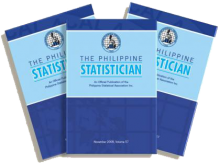| 1. | Modelling Portfolio Risk and Diversification Effects of a Portfolio Using the Exponential Distribution – Bivariate Archimedean Gumbel Copula Model | Owen Jakata and Delson Chikobvu | 2023 | 72 | 1 |  |
| 2. | Local Quadratic Regression: Maximizing Performance via a Modified PRESS** for Bandwidths Selection | E. Edionwe and O. Eguasa | 2023 | 72 | 1 |  |
| 3. | Spatiotemporal Patterns of COVID-19 Cases in Quezon City, Philippines | Tricia Janylle B. Sta. Maria, Nancy E. Añez-Tandang, and Edrun R. Gayosa | 2023 | 72 | 1 |  |
| 4. | Utilization of Machine Learning, Government-Based and Non-Conventional Indicators for Property Value Prediction in the Philippines | Gabriel Isaac L. Ramolete, Bryan Bramaskara, Dustin A. Reyes, and Adrienne Heinrich | 2023 | 72 | 1 |  |
| 5. | Verification of Coffee Product Form and Determination of Conversion Rate From Coffee Dried Berries to Green Coffee Beans (GCB) | Dennis S. Mapa, Ph.D., Divina Gracia L. Del Prado, Ph.D., Vivian R. Ilarina, Rachel C. Lacsa, Manuela S. Nalugon, Abella A. Regala, Marivic C. De Luna, and Ray Francis B. De Castro | 2022 | 71 | 2 |  |
| 6. | Determination of Dry Rubber Content of Rubber Cup Lump | Claire Nova O. Abdulatip and Honey Fe G. Boje | 2022 | 71 | 2 |  |
| 7. | Topic Identification and Classification of GooglePlay Store Reviews | Daniel David M. Pamplona | 2022 | 71 | 2 |  |
| 8. | A Bayesian Hierarchical Model for COVID-19 Cases in Mindanao Philippines | Jejemae D. Nacion and Bernadette F. Tubo | 2022 | 71 | 2 |  |
| 9. | Hierarchical Bayesian Model for Correcting Reporting Delays in Dengue Counts | Mikee T. Demecillo and Bernadette F. Tubo | 2022 | 71 | 2 |  |
| 10. | Estimating the Magnitude of the Poor Households in Metro Manila Using the Poisson Regression Model | Bernadette B. Balamban, Anna Jean C. Pascasio, Driesch Lucien R. Cortel and Maxine R. Ridulme | 2022 | 71 | 2 |  |
| 11. | Application of Consecutive Sampling Technique in a Clinical Survey for an Ordered Population: Does it Generate Accurate Statistics? | Mohamad Adam Bujang, Tg Mohd Ikhwan Tg Abu Bakar Sidik, and Nadiah Sa'at | 2022 | 71 | 1 |  |
| 12. | On Some Efficient Classes of Estimators Based on Higher Order Moments of an Auxiliary Attribute | Shashi Bhushan and Anoop Kumar | 2022 | 71 | 1 |  |
| 13. | An Application of CATANOVA and Logistic Regression on the Most Prevalent Sexually Transmitted Infection (A Case Study of the University of Nigeria Teaching Hospital) | Nnaemeka Martin Eze, Oluchukwu Chukwuemeka Asogwa, Samson Offorma Ugwu, Chinonso Michael Eze, Felix Obi Ohanuba, Tobias Ejiofor Ugah | 2022 | 71 | 1 |  |
| 14. | Analytic Hierarchy Process with Rasch Measurement in the Construction of a Composite Metric of Student Online Learning Readiness Scale | Joyce DL. Grajo, James Roldan S. Reyes1, Liza N. Comia, Lara Paul A. Ebal, Jared Jorim O. Mendoza, and Mara Sherlin DP. Talento | 2022 | 71 | 1 |  |
| 15. | Implementing an Effective Survey Operations for a Research and Development Survey in the Philippines | Ramoncito G. Cambel, Dalisay S. Maligalig, Maurice C. Borromeo, and Ronald R. Roldan Jr., and Clifford B. Lesmoras | 2022 | 71 | 1 |  |
| 16. | Analysis of Longitudinal Data with Missing Values in the Response and Covariates Using the Stochastic EM Algorithm | Ahmed M. Gad and Nesma M. Darwish | 2022 | 71 | 1 |  |
| 17. | Two New Tests for Tail Independence in Extreme Value Models | Mohammad Bolbolian Ghalibaf | 2021 | 70 | 2 |  |
| 18. | Time Series Prediction of CO2 Emissions in Saudi Arabia Using ARIMA, GM(1,1), and NGBM(1,1) Models | Z. F. Althobaiti, and A. Shabri | 2021 | 70 | 2 |  |
| 19. | Classes of Estimators under New Calibration Schemes using Non-conventional Measures of Dispersion | A. Audu, R. Singh, S. Khare, N. S. Dauran | 2021 | 70 | 2 |  |
| 20. | A New Compound Probability Model Applicable to Count Data | Showkat Ahmad Dar, Anwar Hassan, Peer Bilal Ahmad and Bilal Ahmad Para | 2021 | 70 | 2 |  |

